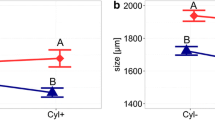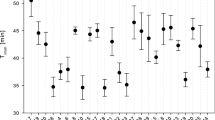Abstract
Diaphanosoma dubium Manuilova from (sub)tropical South China, cultured in the laboratory at 23–29°C, did not show a shortening of its lifespan at increasing temperatures, although its postembryonic development shortened, while individual clutch sizes became bigger. The optimum temperature for the population performance of this species (measured as lifetime fecundity or intrinsic rate of increase) therefore lies above 29°C. Limited literature data suggest that in tropics-adapted species, the shortening of the lifespan with temperature, which follows a quadratic function, reverses at higher temperatures. Thus, the most general descriptor of the complete temperature-lifespan relationship might be a parabola. D. dubium did not show shorter lifespans when offered more food either, and again shared this characteristic with few other tropical cladocerans (and probably copepods as well) studied by other authors. Both properties combined might be typical of tropical species and offer them an advantage (a long, prolific life in warm water rich in algae) over temperate species (like Daphnia) that, if occurring in the tropics at all, live above their temperature optimum there.




Similar content being viewed by others
References
Amarasingha, P. B., M. Boersma & J. Vijverberg, 1997. The effect of temperature and food quantity and quality on the growth and development rates in laboratory-cultured copepods and cladocerans from a Sri Lanka reservoir. Hydrobiologia 350: 131–144.
Bottrell, H. H., 1975. Generation time, length of life, instar duration and frequency of moulting, and their relationship to temperature in eight species of cladocera from the River Thames, Reading. Oecologia 19: 129–140.
Bottrell, H. H., A. Duncan, Z. M. Gliwicz, E. Grygierek, A. Herzig, A. Hillbricht-Ilkowska, H. Kurasawa, P. Larsson & T. Weglenska, 1976. A review of some problems in zooplankton production studies. Norwegian Journal of Zoology 24: 419–456.
Brown, L. A., 1938. The natural history of cladocerans in relation to temperature I. Distribution of the temperature limits for vital activities. American Naturalist 63: 248–264.
Dumont, H. J., 1994. On the diversity of the Cladocera in the tropics. Hydrobiologia 272: 27–38.
Duncan, A., 1989. Food limitation and body size in the life cycles of planktonic rotifers and cladocerans. Hydrobiologia 186(187): 11–28.
Dunham, H. H., 1938. Abundant feeding followed by restricted feeding and longevity in Daphnia. Physiological Zoology 11: 399–407.
Gras, R. & L. Saint Jean, 1969. Biologie des crustacés du lac Tchad. 1. Durée de développement embryonnaire et post-embryonnaire: premiers résultats. Cahiers ORSTOM, Série Hydrobiologique 3: 43–60.
Gras, R. & L. Saint Jean, 1978. Durée et caractéristiques du développement juvenile de quelques cladocères du lac Tchad. Cahiers d’ORSTOM, Série Hydrobiologique 12: 119–136.
Hardy, E. R. & A. Duncan, 1994. Food concentration and temperature effects on life cycle characteristics of tropical Cladocera (Daphnia gessneri Herbst, Diaphanosoma sarsi Richard, Moina reticulata (Daday)): I Development time. Acta Amazonica 24: 119–134.
Hart, R. C., 1985. Embryonic development times of entomostracan zooplankton from Lake le Roux (Orange River, South Africa), and their possible relationships to seasonal succession. Hydrobiologia 127: 17–26.
Hart, R. C., 2000 (2001). Comparative long-term periodicity of Diaphanosoma excisum in adjacent warm-water impoundments, with an evaluation of contributory factors. Verhandlungen Internationale Vereinigung Limnologie 27: 1933–1939.
Hart, R. C., 2004. Cladoceran periodicity patterns in relation to selected environmental factors in two cascading warm-water reservoirs over a decade. Hydrobiologia 526: 99–117.
Hebert, P. D. N., 1978. The population biology of Daphnia (Crustacea, Daphniidae). Biological Reviews 53: 387–426.
Heip, C., 1974. A comparison between models describing the influence of temperature on the development rate of Copepods. Biologisch Jaarboek Dodonaea 42: 121–125.
Herzig, A., 1983. The ecological significance of the relationship between temperature and duration of embryonic development in planktonic freshwater copepods. Hydrobiologia 100: 65–91.
Herzig, A., 1984. Temperature and life cycle strategies of Diaphanosoma brachyurum: an experimental study on development, growth, and survival. Archiv für Hydrobiologie 101: 143–178.
Ingle, L., 1933. Effects of environmental conditions on longevity. Science 78: 511–513.
Ingle, L., T. R. Wood & A. M. Banta, 1937. A study of longevity, growth, reproduction and heart rate in Daphnia longispina as influenced by limitations in quantity of food. Journal of Experimental Zoology 76: 325–352.
Jana, B. B. & G. P. Pal, 1984. The life history parameters of Diaphanosoma excisum (Cladocera) grown in different culturing media. Hydrobiologia 118: 205–212.
Korovchinsky, N. M., 1992. Sididae and Holopediidae (Crustacea: Daphniiformes). Guides to the Identification of the freshwater microinvertebrates of the World, Vol. 1. SPB, The Hague.
Lampert, W., 1977. Studies on the carbon balance of Daphnia pulex De Geer as related to environmental conditions IV. Determination of a “threshold” concentration as a factor controlling the abundance of zooplankton species. Archiv fur Hydrobiologie Supplement 48: 361–368.
Lemke, A. M. & A. C. Benke, 2003. Growth and reproduction of three cladoceran species from a small wetland in the south-eastern USA. Freshwater Biology 48: 589–603.
MacArthur, J. W. & W. H. T. Baillie, 1929. Metabolic activity and duration of life I. Influence of temperature on longevity in Daphnia magna. Journal of Experimental Zoology 53: 221–242.
Mavuti, K. M., 1994. Durations of development and production estimates by two crustacean zooplankton species Thermocyclops oblongatus Sars (Copepoda) and Diaphanosoma excisum Sars (Cladocera), in Lake Navaisha, Kenya. Hydrobiologia 272: 185–200.
Pagano, M., 2008. Feeding of tropical cladocerans (Moina micrura, Diaphanosoma excisum) and rotifer (Brachionus calyciflorus) on natural phytoplankton: effect of phytoplankton size-structure. Journal of Plankton Research 30: 401–414.
Peters, R. H. & R. De Bernardi (eds), 1987. Daphnia. Memorie del Istituto Italiano di Idrobiologia 45: 502.
Pianka, E. R., 2000. Evolutionary Ecology, 3rd ed. Harper & Row, New York: 468.
Repka, S., 1997. Effects of food type on the life history of Daphnia clones from lakes differing in trophic state I. Daphnia galeata feeding on Scenedesmus and Oscillatoria. Freshwater Biology 37: 675–683.
Sarma, S. S. S., S. Nandini & R. D. Gulati, 2005. Life history strategies in Cladocera: comparisons of tropical and temperate taxa. Hydrobiologia 542: 315–333.
Schwartz, S. S., 1984. Life history strategies in Daphnia: a review and predictions. Oikos 42: 114–122.
Vijverberg, J., 1989. Culture techniques for studies on the growth, development and reproduction of copepods and cladocerans under laboratory and in situ conditions: a review. Freshwater Biology 21: 317–373.
Acknowledgments
Support from NSF China (No. 30670345 and U0733007) to BP Han is appreciated. We are also grateful to our colleagues, R. Gulati, R. Hart and M. Pagano, whose insights greatly helped us formulate our ideas.
Author information
Authors and Affiliations
Corresponding author
Additional information
Guest editors: H. J. Dumont, J. E. Havel, R. Gulati & P. Spaak / A Passion for Plankton: a tribute to the life of Stanley Dodson
Rights and permissions
About this article
Cite this article
Han, BP., Yin, J., Lin, X. et al. Why is Diaphanosoma (Crustacea: Ctenopoda) so common in the tropics? Influence of temperature and food on the population parameters of Diaphanosoma dubium, and a hypothesis on the nature of tropical cladocerans. Hydrobiologia 668, 109–115 (2011). https://doi.org/10.1007/s10750-010-0501-7
Received:
Accepted:
Published:
Issue Date:
DOI: https://doi.org/10.1007/s10750-010-0501-7




